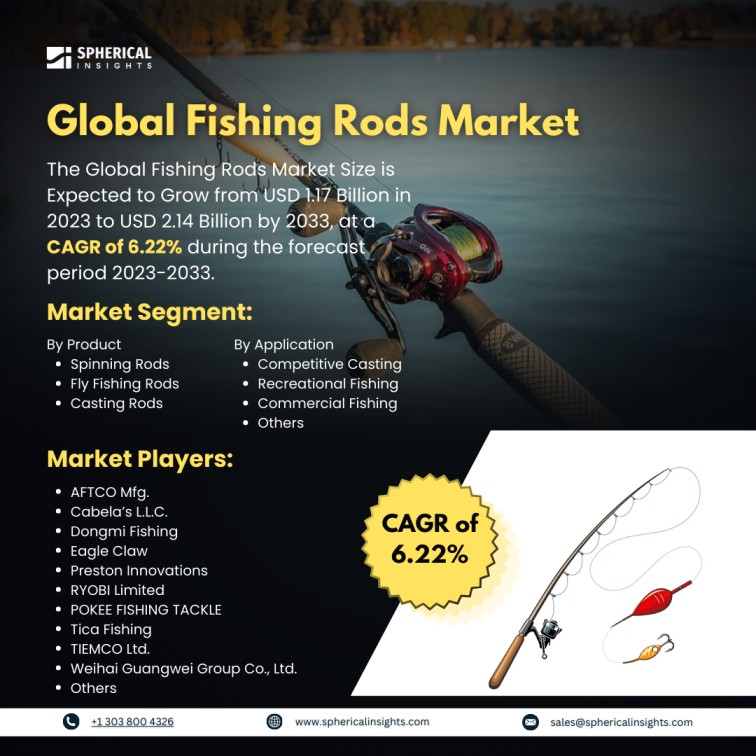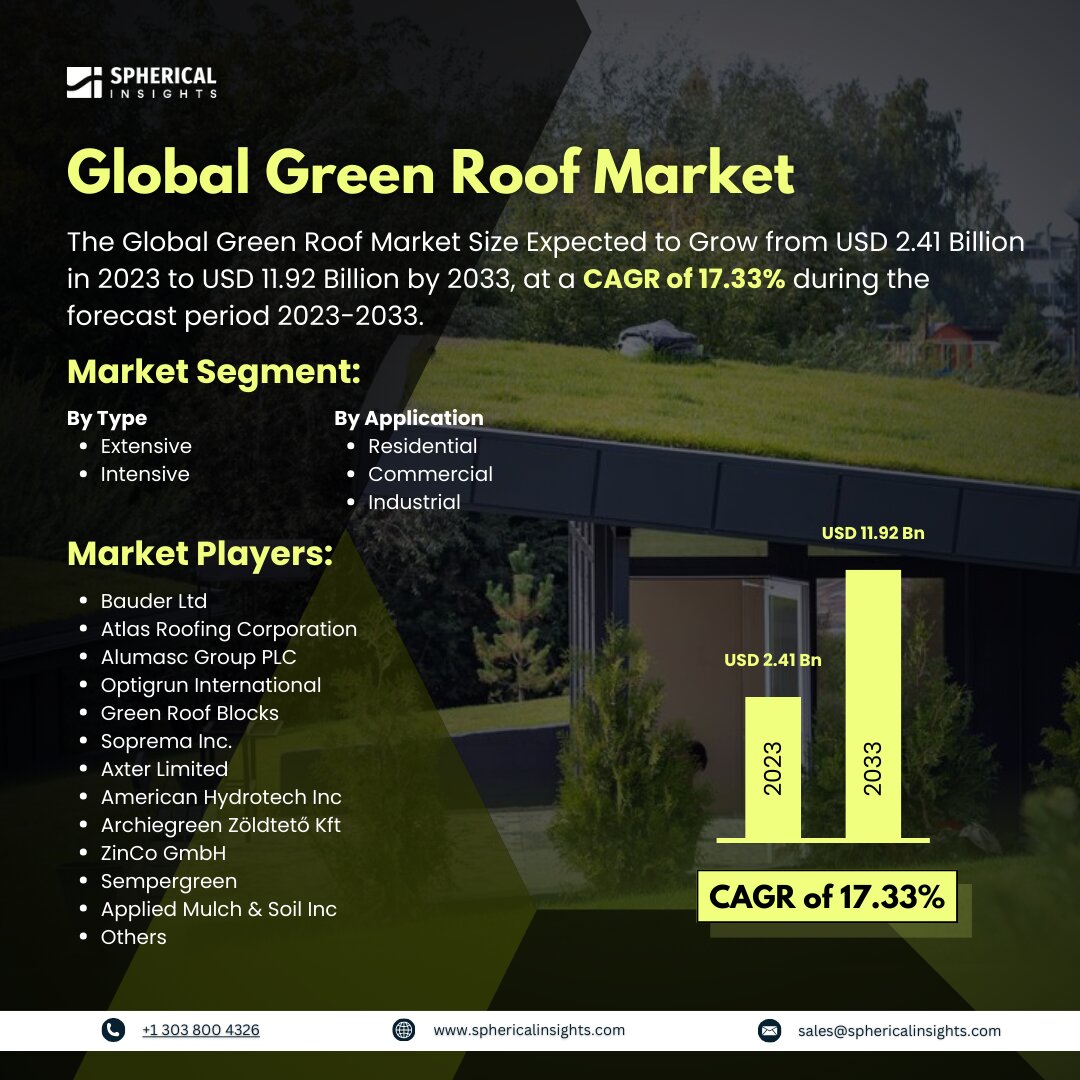Global Fishing Rods Market Size to worth USD 2.14 Billion by 2033
According to a research report published by Spherical Insights & Consulting, the Global Fishing Rods Market Size is Expected to Grow from USD 1.17 Billion in 2023 to USD 2.14 Billion by 2033, at a CAGR of 6.22 % during the forecast period 2023-2033.
Browse key industry insights spread across 210 pages with 110 Market data tables and figures & charts from the report on the Global Fishing Rods Market Size, Share, and COVID-19 Impact Analysis, By Product (Spinning Rods, Fly Fishing Rods, and Casting Rods), By Application (Competitive Casting, Recreational Fishing, Commercial Fishing, and Others), and By Region (North America, Europe, Asia-Pacific, Latin America, Middle East, and Africa), Analysis and Forecast 2023 – 2033.
The fishing rod market encompasses the production and distribution of rods used for recreational and professional fishing. These rods, crafted from materials such as carbon fiber, fiberglass, and graphite, are designed to provide durability, flexibility, and precision during fishing activities. The market serves diverse fishing styles, including fly fishing, spinning, and baitcasting, catering to various skill levels and preferences of anglers. The market is primarily driven by the rising popularity of recreational fishing activities worldwide, which are promoted as a leisure pursuit and a means of connecting with nature. Technological advancements in rod manufacturing, such as lightweight materials and improved casting accuracy, further enhance market growth. Additionally, the increasing participation in competitive fishing tournaments and the expanding global fishing tourism industry contribute significantly to market expansion. However, certain factors restrain the growth of the fishing rod market. The high cost of advanced fishing rods, especially those designed for specialized fishing techniques, limits their adoption among casual or occasional anglers.
The spinning rods segment accounted for the largest share in 2023 and is expected to grow at a significant CAGR during the forecast period.
Based on the product, the fishing rods market is classified into spinning rods, fly fishing rods, and casting rods. Among these, the spinning rods segment accounted for the largest share in 2023 and is expected to grow at a significant CAGR during the forecast period. The dominance of this segment can be attributed to the versatility and ease of use offered by spinning rods, making them highly popular among both amateur and experienced anglers. Spinning rods are suitable for various fishing conditions, including freshwater and saltwater environments, and are compatible with a wide range of lures and bait types, further driving their demand.
The recreational fishing segment accounted for the largest share in 2023 and is expected to grow at a significant CAGR during the forecast period.
Based on the application, the fishing rods market is divided into competitive casting, recreational fishing, commercial fishing, and others. Among these, the recreational fishing segment accounted for the largest share in 2023 and is expected to grow at a significant CAGR during the forecast period. The prominence of this segment is driven by the increasing popularity of recreational fishing as a leisure activity and a means of relaxation, particularly in developed and developing regions. Growing urbanization, rising disposable incomes, and government initiatives promoting outdoor activities have further bolstered the demand for fishing rods in this segment.
Europe is estimated to hold the largest fishing rods market share over the forecast period.
Europe is estimated to hold the largest fishing rods market share over the forecast period. The region is bolstered by numerous fishing events and competitions, fostering community engagement. Rising disposable incomes empower consumers to purchase high-quality fishing gear. Technological advancements in rod materials enhance performance and durability, while the trend toward sustainable fishing practices encourages the adoption of specialized equipment.
North America is predicted to have the fastest CAGR growth in the fishing rods market over the forecast period. Large expanses of water and multiple fish species present numerous opportunities to fishermen. Disposable income enhances the capacity to spend money on quality, highly specialized rods. Fishing tournaments grow in popularity to engage more of the community as well as build competition among fishers, with improvements in rods increasing their efficiency, so encouraging beginners as well as pros to use them.
Competitive Analysis
Major key players in the fishing rods market are AFTCO Mfg., Cabela’s L.L.C., Dongmi Fishing, Eagle Claw, Preston Innovations, RYOBI Limited, POKEE FISHING TACKLE, Shakespeare, SHIMANO INC., St. Croix Rods, Tica Fishing, TIEMCO Ltd., Weihai Guangwei Group Co., and Ltd.
Key Target Audience
- Market Players
- Investors
- End-users
- Government Authorities
- Consulting And Research Firm
- Venture capitalists
- Value-Added Resellers (VARs)
Recent Development
- In November 2024, the MLF Fisheries Management Division collaborated with American Feeder, TPWD, and local volunteers to complete habitat restoration projects in Early, Texas, enhancing fishing opportunities and supporting local conservation efforts.
Market Segment
This study forecasts global, regional, and country revenue from 2023 to 2033. Spherical Insights has segmented the fishing rods market based on the below-mentioned segments:
Global Fishing Rods Market, By Product
- Spinning Rods
- Fly Fishing Rods
- Casting Rods
Global Fishing Rods Market, By Application
- Competitive Casting
- Recreational Fishing
- Commercial Fishing
- Others
Global Fishing Rods Market, By Regional Analysis
- North America
- Europe
- Germany
- UK
- France
- Italy
- Spain
- Russia
- Rest of Europe
- Asia Pacific
- China
- Japan
- India
- South Korea
- Australia
- Rest of Asia Pacific
- South America
- Brazil
- Argentina
- Rest of South America
- Middle East & Africa
- UAE
- Saudi Arabia
- Qatar
- South Africa
- Rest of the Middle East & Africa



